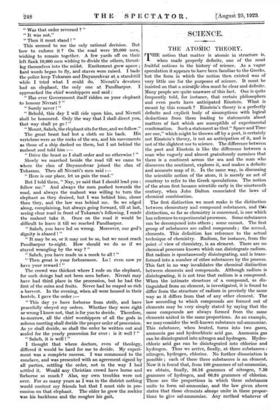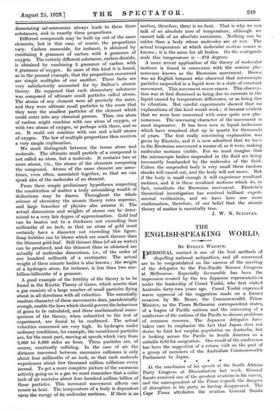SCIENCE.
THE ATOSIIC THEORY.
THE notion that matter is atomic in structure is, when made properly definite, one of the most fruitful notions. in the history of science. As a vague speculation it appears to have been familiar to the Greeks, but the form. in which the notion then existed was of very little use for the purposes of science. It must be insisted on that a scientific idea must be 'clear and definite. Many people are quite unaware of this fact. One is quite frequently fold, for instance, that certain philosophers and eveft poets have anticipated Einstein. What is meant by this remark ? Einstein's theory' is a perfectly definite and explicit. body of aSsumptions with logical deductions from them leading to statements about matters of fact which are susceptible of experimental confirmation. Such a statement as that" Space and Time are one," which might be thrown off by a poet, is certainly not Einstein's theory, is not an anticipation of it, and is not of the slightest use to science. The difference between the poet and Einstein is like the difference between a man who vaguely and almost gratuitously surmises that there is a continent across the sea and the man who discovers the continent, explores it, and makes a definite and accurate map of it. In the same way, in discussing the scientific notion of the atom, it is merely an act of courtesy to refer to the Greek speculations. The notion of the atom first became scientific early in the nineteenth century, when John Dalton enunciated the laws of chemical combination.
The first distinction we must make is the distinction between elementary and compound substances, and this distinction, so far as chemistry is concerned, is one which has reference to experimental processes. Some substances can be decomposed into others ; some cannot. The first group of substances are called compounds ; the second, elements. This definition has reference to the actual technique of chemistry. Radium, for instance, from the point of view of chemistry, is an element. There are no chemical processes known which can disintegrate radium. But radium is spontaneously disintegrating, and is trans- formed into a number of other substances by the process. This fact in no way invalidates the chemical distinction between elements and compounds. Although radium is disintegrating, it is not true that radium is a compound. When the intimate structure of a compound, as dis- tinguished from an element, is investigated, it is found to differ from the structure of radium in precisely the same way as it differs from that of any other element: The law according to which compounds are formed out of elements may be very simply stated by saying that the same compounds are always formed from the same elements united in the same proportions. As an example, we may consider the well-known substance sal-ammoniac. This substance, when heated, turns into two gases, ammonia gas and hydrochloric acid gas. Ammonia gas can be disintegrated into nitrogen and hydrogen. Hydro- chloric acid gas can be disintegrated into chlorine and hydrogen. Thus we arrive, finally, at three substances : nitrogen, hydrogen, chlorine. No further dissociation is possible ; each of these three substances is an element. Now it is found that, from 100 grammes of sal-ammoniac, we obtain, finally, 26.16 grammes of nitrogen, 7.50 grammes of hydrogen, and 66.84 grammes of chlorine. These are the proportions in which these substances unite to form sal-ammoniac, and the law given above states that these elements always unite in these propor- tiont to give sal-amnaohiac. Any method whatever of Elissociating sal-ammoniac always leads to these three substances, and in exactly these proportions.
Different compounds may be built up out of the same elements, but in this case, of course, the proportions vary.' Carbon monoxide, for instance, is obtained by combining 8 grammes of carbon with 4 grammes of oxygen. The entirely different substance, carbon dioxide, is obtained by combining 8 grammes of carbon with 8 grammes of oxygen. In cases of this kind it is found, as in the present example, that the proportions concerned are simple multiples of one another. These facts are very satisfactorily accounted for by Dalton's atomic theory. He supposed that each elementary substance was composed of ultimate small particles called atoms. The atoms of any element were all precisely the same, and they were ultimate small particles in the sense that they were the smallest particles of the element which could enter into any chemical process. Thus, one atom of carbon might combine with one atom of oxygen, or with two atoms of oxygen, or perhaps with three, and so on. It could not combine with one and a-half atoms of oxygen. The law of multiple proportions thus receives a very simple explanation.
We must distinguish between the terms atom and molecule. The ultimate small particle of a compound is not called an atom, but a molecule. It contains two or more atoms, viz., the atoms of the elements composing the compound. Atoms of the same element are some- times, even often, associated together, so that we can speak also of the molecules of an element.
From these simple preliminary hypotheses respecting the constitution of matter a truly astonishing wealth of deductions may be drawn. Throughout the whole science of chemistry the atomic theory rules supreme, and large branches of physics also assume it. The actual dimensions and weights of atoms can be deter- mined to a very fair degree of approximation. Gold leaf can be beaten out to a thickness not exceeding four millionths of an inch, so that an atom of gold must certainly have a diameter not exceeding this figure. Soap bubbles can be blown which are much thinner than the thinnest gold-leaf. Still thinner films (of oil on water) can be produced, and the thinnest films so obtained are actually of molecular dimensions, i.e., of the order of one hundred millionth of a centimetre. The actual weight of these minute bodies is also known ; the weight of a hydrogen atom, for instance, is less than two one- billion-billionths of a gramme.
A good example of the fertility of the theory is to be found in the Kinetic Theory of Gases, which asserts that a gas consists of a large number of small particles flying about in all directions with all velocities. The essentially random character of these movements does, paradoxically enough, enable the laws which should govern the behaviour of gases to be calculated, and these mathematical conse- quences of the theory, when submitted to the test of experiment, are found to be confirmed. The actual velocities concerned are very high. In hydrogen under ordinary conditions, for example, the constituent particles are, for the most part, moving at speeds which vary from 2,000 to 8,000 miles an hour. These particles are, of course, constantly colliding. In the case of air the distance _traversed between successive collisions is only about four millionths of an inch, so that each molecule experiences about five thousand million collisions every second. To get a more complete picture of the enormous activity going on in a gas we must remember that a cubic inch of air contains about four hundred million billion of these particles. This incessant movement affects our senses as heat. The temperature of a body is dependent upon the energy of its molecular motions. If there is no motion, therefore, there is no heat. That is why we can talk of an absolute zero of temperature, although we cannot talk of an absolute maximum. Nothing can be colder than a body whose molecules are at rest. The actual temperature at which molecular motion ceases is known ; it is the same for all bodies. On the centigrade scale this temperature is -278 degrees.
A more recent application of the theory of molecular motions is found in connexion with the curious phe- nomenon known as the Brownian movement. Brown was an English botanist who observed that microscopic particles suspended in a liquid were in a state of constant movement. This movement never ceases. This observa- tion was at first dismissed as being due to currents in the liquid caused by temperature differences, or as being due to vibration. But careful experiments showed that no explanations of this kind would work ; it became evident that we were here concerned with some quite new phe- nomenon. The unceasing character of the movement is most impressive. It has been seen in liquid inclusions which have remained shut up in quartz for thousands of years. The first really convincing explanation was given by Einstein, and it is now admitted that we have in the Brownian movement a means of, as it were, making molecular motions visible. For we must imagine that the microscopic bodies suspended in the fluid are being incessantly bombarded by the molecules of the fluid. Unless the suspended body is very small these random shocks will cancel out, and the body will not move. But if the body is small enough it will experience resultant motions, and it is these resultant motions which do, in fact, constitute the Brownian movement. Einstein's theoretical investigation has received brilliant experi- mental verification, and we have here one more confirmation, therefore, of our belief that the atomic theory of matter is essentially true.
J. W. N. SULLIVAN.



































 Previous page
Previous page